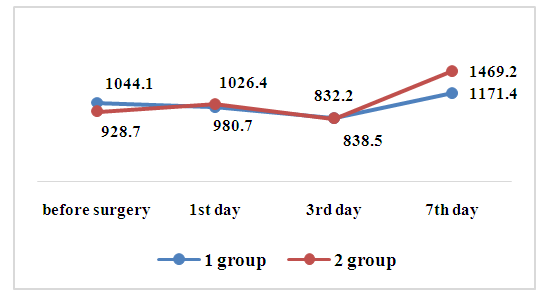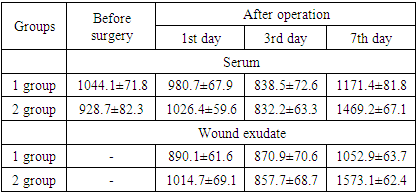-
Paper Information
- Next Paper
- Previous Paper
- Paper Submission
-
Journal Information
- About This Journal
- Editorial Board
- Current Issue
- Archive
- Author Guidelines
- Contact Us
American Journal of Medicine and Medical Sciences
p-ISSN: 2165-901X e-ISSN: 2165-9036
2022; 12(12): 1232-1234
doi:10.5923/j.ajmms.20221212.12
Received: Nov. 15, 2022; Accepted: Dec. 3, 2022; Published: Dec. 9, 2022

State of the Oxidative Status of the Organism in Patients with Postoperative Ventral Hernias During Endoprosthetics
K. F. Zuparov1, N. Ya. Fayzullaeva2, A. A. Tursumetov1, T. A. Askarov1
1Tashkent Pediatric Medical Institute, Tashkent, Uzbekistan
2Institute of Immunology and Human Genomics, Tashkent, Uzbekistan
Copyright © 2022 The Author(s). Published by Scientific & Academic Publishing.
This work is licensed under the Creative Commons Attribution International License (CC BY).
http://creativecommons.org/licenses/by/4.0/

Hernioplasty currently ranks first in terms of the number of operations in abdominal surgery. Over 5% of all laparotomies are complicated by the formation of postoperative ventral hernias. A fundamentally important condition for the successful treatment of patients with postoperative ventral hernias is the need to assess oxidative stress by determining the level of superoxide dismutase both before surgery and in the postoperative period. A study of superoxide dismutase (SOD) in patients with POVH over time was carried out.In the first stage, a retrospective comparative study of the results of the surgical treatment of 127 patients with POVH for the period 2018–2021 was carried out. Among 127 patients, there were 33 men (26%), with a mean age of 52.9 ± 2.73 years, and 94 women (74%), with a mean age of 56.2 ± 1.3 years. The inclusion criteria for this group were the presence of a postoperative ventral hernia in a patient who agreed to an immunological examination and planned surgical treatment in TashPMI clinics. using a polypropylene mesh implant manufactured by Lintex”, Esfil standard, and Esfil easy (Saint Petersburg, Russia).To conduct this study, 2 groups were formed: 27 patients in the first group with the use of Esfil-heavy and 34 patients in the second group with Esfil-light.Based on research can be following conclusions: The correction of postoperative ventral hernias by the alloplasty method reduces the process of destructive changes and is accompanied by the normalization of the antioxidant status both at the systemic and local levels. The use of Esfil-Light during alloplasty provides a more rapid recovery of the antioxidant status, while demonstrating high safety and efficacy.
Keywords: Postoperative ventral hernias, Superoxide dismutase
Cite this paper: K. F. Zuparov, N. Ya. Fayzullaeva, A. A. Tursumetov, T. A. Askarov, State of the Oxidative Status of the Organism in Patients with Postoperative Ventral Hernias During Endoprosthetics, American Journal of Medicine and Medical Sciences, Vol. 12 No. 12, 2022, pp. 1232-1234. doi: 10.5923/j.ajmms.20221212.12.
1. Introduction
- The problem of treating patients with complex postoperative ventral hernias is one of the most urgent and difficult tasks of modern surgery [1,3,6]. The share of this pathology in the structure of hernia disease currently reaches 21–30.7% and does not tend to decrease [3,7].Postoperative ventral hernias account for 5–11% of all complications after laparotomy [3,4]. The urgency of the problem is also due to the high frequency of wound complications after hernioplasty [1,4], recurrence of hernia formation [5,3].The human antioxidant system (AOS) is a system that blocks the formation of highly active free radicals, i.e., reactive oxygen species [9]. Under normal physiological conditions, small amounts of oxygen are constantly converted into superoxide anions, hydrogen peroxide, and hydroxyl radicals. Excessive production of these radicals is a damage factor, the compensatory mechanism for which is the antioxidant system [8,9]. Among AOS enzymes, first of all, superoxide dismutase (SOD) should be singled out - an antioxidant, which is the first link of protection. This enzyme is found in all cells that consume oxygen. The role of superoxide dismutase is to accelerate the reaction of the transformation of the oxygen radical toxic to the body - superoxide into hydrogen peroxide and molecular oxygen.The determination of the total antioxidant status helps the clinician to better assess the state of the organism and its potential protective reserves under certain physiological and pathological conditions.The purpose of the study was to evaluate the possible relationship between the amount of implanted polypropylene and postoperative oxidative stress and thus evaluate, if any, differences in response and biotolerance between Esfil heavy and Esfil light meshes.
2. Materials and Methods
- In the first stage, a retrospective comparative study of the results of the surgical treatment of 127 patients with POVH for the period 2018–2021 was carried out. Among 127 patients, there were 33 men (26%), with a mean age of 52.9 ± 2.73 years, and 94 women (74%), with a mean age of 56.2 ± 1.3 years. The minimum age of the patients was 21 years, the maximum was 83 years, and the average age of all patients was 55.3 ± 1.2 years. Patients suffering from diabetes, liver cirrhosis, any chronic inflammatory disease, or receiving corticosteroids and/or immunosuppressive therapy (patients with neoplasms) were excluded from the study. The analysis took into account the variations in the course of the wound process:- the wound healing process without complications - the course of the wound process with prolonged wound exudation;- wound complications (seroma, suppuration of the wound, necrotizing cellulitis).In the second stage, for the period 2018–2021, a prospective study was performed on 80 patients with incisional ventral hernias.The inclusion criteria for this group were the presence of a postoperative ventral hernia in a patient who agreed to an immunological examination and planned surgical treatment in TashPMI clinics. using a polypropylene mesh implant manufactured by "Lintex”, Esfil standard, and Esfil easy (Saint Petersburg, Russia).To conduct this study, 2 groups were formed: 27 patients in the first group with the use of "Esfil-heavy" and 34 patients in the second group with "Esfil-light".We monitored the patients in the first and second groups.All patients with postoperative ventral hernias had abdominal wall alloplasties as a result of surgical treatment. By the nature of the operations performed, by the localization and size of the hernial defect, age, gender, and other indicators, the studied groups were comparable.The level of superoxide dismutase (SOD) was determined by enzyme immunoassay using a Human Reader HS analyzer (Germany) using ELISA-SOD test systems (OOO Cytokin, St. Petersburg, Russia).When working with data, descriptive statistical methods were used: point estimates of the mean (M) and standard deviation (SD) were determined. Checking for the normality of the values of indicators in the samples was done graphically and using the Shapiro-Wilks test. When the distributions of values in the samples deviated from the normal distribution, the nonparametric Mann-Whitney test was used for independent samples and the Wilcoxon test for dependent samples.
3. Results and Discussion
- In patients with postoperative ventral hernias (POVH) during arthroplasty with polypropylene meshes Esfil-heavy (group 1) and Esfil-light (group 2) in the early stages after surgery - on the 1st, 3rd and 7th days after operation, we studied the level of SOD in parallel in two biological fluids of the body - in blood serum and wound exudate (Table 1). Also, the level of SOD was determined in the blood serum of 20 healthy people of the appropriate age and gender (control group).A comparative analysis of the preoperative level of SOD activity in the blood of patients of groups 1 and 2 with POVH showed that the concentration of SOD in the blood serum (1044.1±71.8 pg/ml and 928.7±82.3 pg/ml, respectively) differed from the level SOD in the control group (1670.5 ± 52.9 pg / ml), and were lower than the values of the control group by an average of 1.6 and 1.8 times, respectively, the difference was statistically significant (Р<0.05). At the same time, a comparison of the level of SOD between the studied groups did not reveal significant differences (Table 1).
|
 | Figure 1. The concentration of SOD in the blood serum in the early stages after surgery in patients of groups 1 and 2 (pg/ml) |
 | Figure 2. SOD concentration in the early postoperative period in wound exudate in patients of groups 1 and 2 (pg/ml) |
4. Conclusions
- 1. The correction of postoperative ventral hernias by the alloplasty method reduces the process of destructive changes and is accompanied by the normalization of the antioxidant status both at the systemic and local levels.2. The use of Esfil-Light during alloplasty provides a more rapid recovery of the antioxidant status, while demonstrating high safety and efficacy.
 Abstract
Abstract Reference
Reference Full-Text PDF
Full-Text PDF Full-text HTML
Full-text HTML